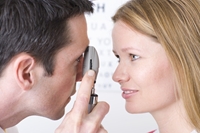 The best way to preserve and protect your vision is through regular professional eye examinations. For teenagers, if corrective lenses are needed, it’s also a matter of determining if you’re “ready” for contacts. This may not be based on any sort of age guidelines – only your willingness to care for and wear lenses properly.
The best way to preserve and protect your vision is through regular professional eye examinations. For teenagers, if corrective lenses are needed, it’s also a matter of determining if you’re “ready” for contacts. This may not be based on any sort of age guidelines – only your willingness to care for and wear lenses properly.
Between examinations, if you notice a change in your vision – or your eye is injured in any way – tell your parents so they can contact your optometrist as soon as possible.
What Can You Expect from a Comprehensive Eye Exam?
Each eye care practitioner has a routine, but most comprehensive eye exams follow a similar pattern. First, the doctor will review your personal and family health history to check for eye disease, diabetes, high blood pressure or poor vision.
Then, your eye doctor will conduct tests to check for:
-
Vision - The practitioner will check for shortsightedness (myopia), longsightedness(hyperopia), and astigmatism. While you look at an eye chart, the practitioner will measure your vision precisely, and, if necessary, determine a prescription for corrective lenses.
-
Coordination of eye muscles - The practitioner will move a light in a set pattern to test your ability to use both eyes together.
-
Side (peripheral) vision - The practitioner will move an object at the edge of your field of vision to make sure you can see it.
-
Pupil response to light - The practitioner will shine a light in each eye and watch the pupil's reaction.
-
Colour testing - The practitioner will ask you to describe figures in a series of illustrations made up of numerous coloured dots or circles. This tests your ability to differentiate colours.
-
Eyelid health and function - The practitioner will examine your eyelid, inside and out.
-
The interior and back of the eye - After dilating your eyes (by both using a few eye drops and dimming the lights so the pupils will widen), the practitioner will use a special instrument called an ophthalmoscope to see through to the retina and optic nerve at the back of the eye. This is where clues to many eye diseases first show up.
-
Measurement of fluid pressure - The practitioner will measure the pressure inside your eye using an instrument called a tonometer. High pressure inside the eye, can be an early indicator of glaucoma and other diseases.
Test Your Vision
While this is not a substitute for a comprehensive eye exam by an eye care practitioner, it may help you test your vision and alert you to a vision problem that requires professional attention. And it’s even kind of fun. You’ll need a friend to help you, so grab someone and try it!
-
Print out the Snellen Eye Chart(17.3 KB, PDF)
-
Tape it on a bare, windowless wall approximately 4 feet above the floor.
-
Sit in a chair 10 feet from the wall. If you normally wear contact lenses or glasses, wear them for this test.
-
Ask your friend to hold a cover (such as a handkerchief or paper cup) over one of your eyes and use a torch to point at each line of the chart, starting at the top. Keeping both eyes open, read each letter out loud as your friend points.
-
Record the number, such as 20/20 or 6/6, of the smallest line you can read correctly.
-
Repeat steps four and five with the other eye.
Most people should be able to read the 20/20 or 6/6 line with both eyes; if you can't, you may need vision correction. Talk to your parents and decide when to make an appointment to see your eye care professional.